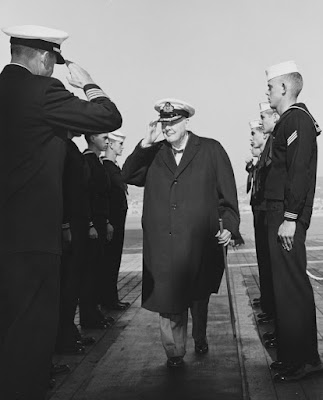 |
| From Kusch's "Merry-go-round." |
Review by Bill Doughty––
Imagine a young artist, heartsick about his nation’s suicidal embrace of autocracy yet called to serve in the military, in a job he admired and excelled in as a patriotic duty. “Joining the navy had been Oskar’s dream ever since he was a little boy.”
Now picture that young man as a German submarine captain in World War II, successful but persecuted for talking down his overlords, especially Adolf Hitler. Oskar Kusch’s principled stand would see him arrested and put on trial for rejecting “the Nazi leadership ideology, practices, and propaganda.”
Rust has strong bonafides to tell this story. A native of Lübeck, Germany, and veteran of the Bundesmarine, Dr. Rust is a professor of history at Baylor University; his father was a submariner for Germany in World War II, and his mother was the widow of a submarine captain killed in the war.
Rust gives us a real feel for submarine duty and the (universal) life of a submariner, for example the CHENG:
“On any submarine, no matter its type, size or nationality, a competent chief engineer was then and remains today key to the boat’s safety, survival, and any successes in combat. Simply understanding and handling the complex technical equipment could be a daunting task. The engineer’s know-how and calm self-control was especially in demand when the boat was diving or surfacing and in keeping its desired trim under all circumstances by manipulating the boat’s fuel tanks, diving cells, and hydroplanes. Given the ever-lurking danger of a sudden attack from the air, U-boats had to dive frequently and fast. For a Type IX boat like U-153, from the moment of the order to dive until the boat was completely under water, ideally no more than 35 seconds were to elapse. Every crew member had to carry out his pre-assigned duties fast and with absolute precision: clearing all personnel from the bridge and the antiaircraft weaponry platforms; flooding the living cells; lowering the angle of the hydroplanes; turning off the diesels and switching to the battery-powered electrical motors for underwater propulsion; shutting airtight all hatch covers and values through which water might otherwise enter the boat; and rushing as many men as possible through the long passageway to the forward torpedo compartment to accelerate the momentum of the dive.”
It is no environment for anyone with claustrophobia or paranoia. And it's no place for back-stabbing subordinates.
 |
| Kusch salutes aboard U-154. |
But in Kusch’s case, he removed a portrait of Hitler from the officers’ mess (replacing it with a picture he created of a schooner); he also openly criticizing ”the Führer” and his policies. Officers serving with Kusch reported him to authorities, and he was arrested. Rust makes a convincing case that Kusch did not demonstrate cowardice or lack of aggressiveness, even in the face of Grand Admiral Karl Dönitz’s desperate kamikaze-like strategies as “Germany’s war effort was failing spectacularly.”
 |
| Grand Admiral Karl Dönitz meets with Adolf Hitler in the Führerbunker in 1945. Hitler named Dönitz as his successor before committing suicide. |
 |
| Some of Kusch's apocalyptic art was created while he was in prison. |
“The picture that has emerged from (Hartwig’s) inquiries reveals Dönitz as a cold and calculating opportunist, a strategic dilettante with a limited grasp of modern technology, and above all as a many exercising a slavish subservience to Hitler and his ideology. Any admiration for Dönitz’s ‘people skills’ vis-à-vis his U-boat men must be balanced against the grand admiral’s perfect willingness to sacrifice them after 1943 to an overpowering Allied supremacy at sea when his earlier concept of a ‘tonnage war’ had lost every meaning or prospect for success –– something Kusch’s experience richly confirmed at the time. The same disdain for human life and suffering governed Dönitz’s directives to abandon shipwrecked enemy sailors to their fate as a desirable measure to weaken Allied manpower resources.”
Rust also describes Germany’s failing totalitarian cause in the final months of the war, “None of the miracle weapons promised by the Nazi propaganda machine had ever materialized.”
 |
| "U-boot" by Ferrer Dalmau (NHHC) |
Rust reveals a “spineless naval brass” unwilling to stand up to “the totalitarian character and ideological infiltration of Germany’s military justice system in World War II.”
According to Rust, "Kusch encouraged the midshipmen in their capacity as future officers, to form their own opinions, to seek and speak the truths at all times, and not to allow their views to be influenced by manipulated propaganda trash. He wanted to "broaden his men's perspectives on history and politics."
Kusch’s tragedy provides lessons for all sailors, leaders, and citizens as an example of what can be done in the face of totalitarianism and autocracy.
“How does one balance patriotic duty as a soldier in a democratic state with the demand that carrying out orders and engaging in military actions should be accompanied and tempered by an ever-active and well-trained conscience? Does Oskar Kusch’s legacy not invite every soldier for all times to come to ask: Are my actions ethical and right? Am I a good comrade? Is my behavior in line with the highest principles of a free and tolerant society? Are the orders I am carrying out just and compatible with the lessons learned from that terrible struggle against totalitarian regimes in the 1930s, 1940s, and others since?”
The life of Oskar Kusch shows us that ethical patriotism is an art to be cherished. His death illustrates the need to learn lessons of the past. Rust's book is a study in core values and is a relevant part of history needed for the present and future.
 |
| Kusch illustrated his own impending death by firing squad. Today, Kusch is revered in Germany for his principled stand against Nazi totalitarianism. |





















